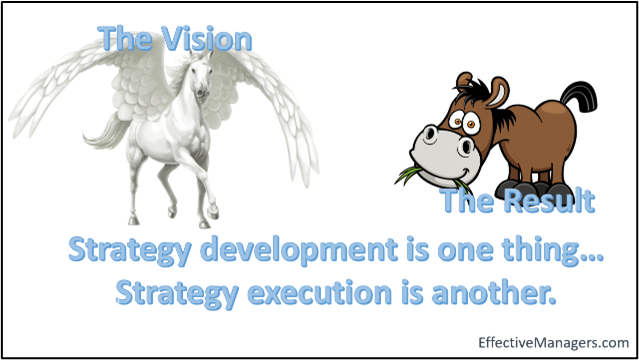It’s a staggering statistic: 70% of organizations fail to achieve their strategic goals.
Most CEOs and executive teams spend considerable time and effort developing thoughtful strategies. Yet, far too often, those strategies stall when it comes time to execute. In today’s environment — with constant disruption from AI, economic uncertainty, inflationary pressures, and ongoing talent shortages — the challenge of execution has never been more pressing.
So why does this happen? Why do so many well-designed strategies fail to deliver results?
Strategy vs. Execution
The truth is, strategy development is not the same as strategy execution.
CEOs are generally strong at setting direction: articulating the vision, defining strategic priorities, and aligning high-level goals. But execution is another story. Execution requires clear accountabilities, coordinated work across functions, and an organization designed to support complexity. When these elements aren’t in place, execution falters.
I call this breakdown organizational churn: the wasted effort that erodes performance when people are unclear about priorities, duplicate effort, or spin in endless cycles of meetings and rework.
The Root Causes of Execution Failure
In my research and consulting work, I’ve seen common systemic issues that explain why execution falls short:
Accountability gaps. When responsibility and authority are not clearly aligned, decisions stall and bottlenecks appear.
Poor organizational design. Roles aren’t always matched to the complexity of work, leaving managers overextended or employees underutilized.
Symptoms of ineffectiveness. Too many meetings, poor communication, rework, and missed deadlines are all signals that churn has taken hold.
These problems are not about “bad people” — they are about systems that CEOs and senior leaders must fix.
The CEO’s Role in Closing the Gap
This is where the six key functions of a CEO come into play. Two are especially critical for bridging the strategy–execution divide:
- Ensuring work is delegated appropriately down the organization. Everyone must know what is expected of them, at the right level of authority.
- Ensuring work flows smoothly across the organization. Cross-functional initiatives succeed only when accountability is crystal clear.
When CEOs focus on clarity of accountability and on designing organizations that truly fit the complexity of the work, the likelihood of execution success rises dramatically.
Practical Steps You Can Take Now
Here are three quick tests to help you gauge your own organization’s readiness for execution:
Check clarity of accountability. For each strategic initiative, is it clear who is accountable for outcomes – not just tasks?
Look for churn. Where are meetings repeating, deadlines slipping, or work duplicated? These are red flags.
Test for fit. Are people in roles that match their problem-solving capability with the complexity of the work required?
If you spot weaknesses in any of these areas, you may be facing an execution gap.
Learn More
These are the types of issues I explore in detail in my book, The Effective CEO: The Balancing Act that Drives Sustainable Performance(). It’s a practical guide for CEOs and executives who want to understand the systems that drive organizational performance and ensure that strategy translates into results.
And this September, I’ll be diving deeper into these concepts during Effective Managers Academy™ Session 2: Business Model and Strategy. This interactive session is designed to give executives practical tools to bridge the gap between strategy and execution.
If strategy execution has been a challenge in your organization, you’re not alone — but you don’t have to stay stuck. Join me at the Effective Managers Academy to learn how to make your strategy work.**
Learn more and register here for Session 2 As part of the launch of the EMAcademy™ this session if free, but registration is limited to allow for interactive discussions.
Order *The Effective CEO* on Amazon. It is available in Kindle and paperback versions.







